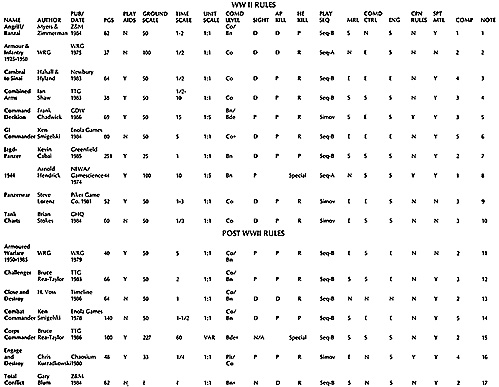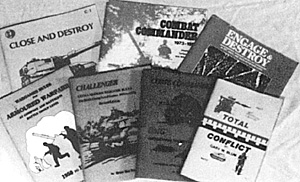
EXPLANATION OF CHART HEADINGS
Scales: yards/minutes/vehicles per inch/turn/miniature respectively.
Command Level: optimal command level for one player.
Sight:
- D - Deterministic: If one is within a unit's sighting range and in LOS, one is seen.
P - Probablistic: If one is at a given range from a unit and in LOS, there is a finite chance that one is seen.
N - None: If one is in a unit's LOS, one is seen.
AP Kill:
- D - Deterministic: Constant armor penetration is used for a given projectile to determine whether the target's armor is defeated.
P - Probablistic: The penetration of a projectile is variable when determining whether the target's armor is defeated, reflecting varying armor and projectile quality and differing impact points (eg: projectile struck a bolthead or a tool attached to the target's hull, etc.).
HE Kill:
- R - Ranged: The likelihood of unit A hitting and damaging unit B with non-antitank fire is modified by the range to unit B.
P - Unranged: The likelihood of unit A hitting and damaging unit B with non-antitank fire is not modified by range.
Play Sequence:
- SEQ-A: Player A moves and fires all units. Player B then does the same.
SEQ-B: Players perform actions sequentially, but both may perform actions in the same phase, eg: Side A move, Side B move, both shoot, Side B move, Side A move.
SIMOV: Players perform all actions simultaneously.
Command Control: N, S, E Not addressed, Simple, Extensive.
Morale (MRL): N, S, E Not addressed, Simple, Extensive.
Engineering: N, S, E Not addressed, Simple, Extensive.
Supporting Materials: what background, equipment data, painting guides, organizational information, etc., are included with the rules?
Complexity: 1 (Simple) to 5 (Complex)
 11. The rules are simple and fast. Chemical warfare and infantry rules are very basic. Artillery and air rules are quite involved. Alternate ground scales are given at 25 and 100 yards per inch. A point system is included. The morale rules are as expected from WRG - detailed.
11. The rules are simple and fast. Chemical warfare and infantry rules are very basic. Artillery and air rules are quite involved. Alternate ground scales are given at 25 and 100 yards per inch. A point system is included. The morale rules are as expected from WRG - detailed.
12.The morale system is somewhat basic. ATGW's are very well integrated to the direct fire system. The air, artillery, and infantry rules are extensive and detailed. Chemical warfare is more involved than WRG, but still basic. 7 Helicopters are well handled, but fixed wing aircraft are somewhat abstractly addressed by the rules. A point system is included. Extensive supporting materials are published under separate covers.
13. Very clearly written. Extensive background, "Getting Started" information equipment data, etc., is included, aimed at making the rulebook a complete package for the gamer. Organization data are included for American, British, Soviet, and German forces. The rules, however, don't address all of the variables of the modern battlefield. Though the fire tables and hit location determination are very detailed, the rules simply don't address chemical warfare, aviation, Command Control, or morale.
14. Detailed! Most rules modify a firer's chance to hit for the type of rangefinder used on a weapon. These rules provide a different set of fire tables for each rangefinder! This, in fact, is the rule throughout this set if a modification to a chart is needed, a new chart is called for. Infantry combat is similarly handled. The chemical warfare charts include separate casualty tables, by weapon type (g-agent, v-agent, etc.), as do the nuke charts. The rules have a lot of potential, but require a lot of effort to play. Comprehensive notes, organization tables, doctrine, and painting guides are included; extensive further organizations are published under separate cover.
15. These rules are operational level, with miniatures representing platoons or batteries. Due to large ground scale (twice the ground scale of any other rules surveyed), combat is very generalized. The player is provided with a much broader range of tactical options, including nukes and chemicals, as higher command levels become directly involved with the game. With hourly turns, supply and logistics actually play a part in these rules -- albeit a somewhat simplified one. Extensive NATO/ WARPAC organizations are included; additional organizations and equipment lists are available under separate cover. A point system is included.
16. A very low level game. Hit location and damage resolution are very detailed. The engineering rules are confined to mine warfare. Naval support rules are present. Command Control is not addressed at all, but morale is examined in great detail, as would be expected of a game att his command level. Extensive notes, data on small unit tactics, operations, painting are included, as is an extensive bibliography. Alternate ground scales given are two, and eight and a third meters per inch. These rules are aimed at the would-be platoon leader, and are quite adequate to the task.
17. These rules are very basic. Individual vehicles may be used, but much of the combat resolution is handled at unit level, which means that if three vehicles fire at a target, "three vehicle firing" combat is resolved, not three "single vehicle firing" combats. Infantry is handled similarly, in multiples of ten men. Ground and time scales are not given, but the ground scale, at least, is suspected to be 50 yards per inch. Some background, bibliography, and unit organizations are given. This is a good set to get right into blasting commies/capitalists with - not very detailed, but fast.
More 20th C. Land Battle Rules A Survey
Back to Table of Contents -- Courier Vol. VII #5
To Courier List of Issues
To MagWeb Master Magazine List
© Copyright 1987 by The Courier Publishing Company.
This article appears in MagWeb (Magazine Web) on the Internet World Wide Web.
Other military history articles and gaming articles are available at http://www.magweb.com